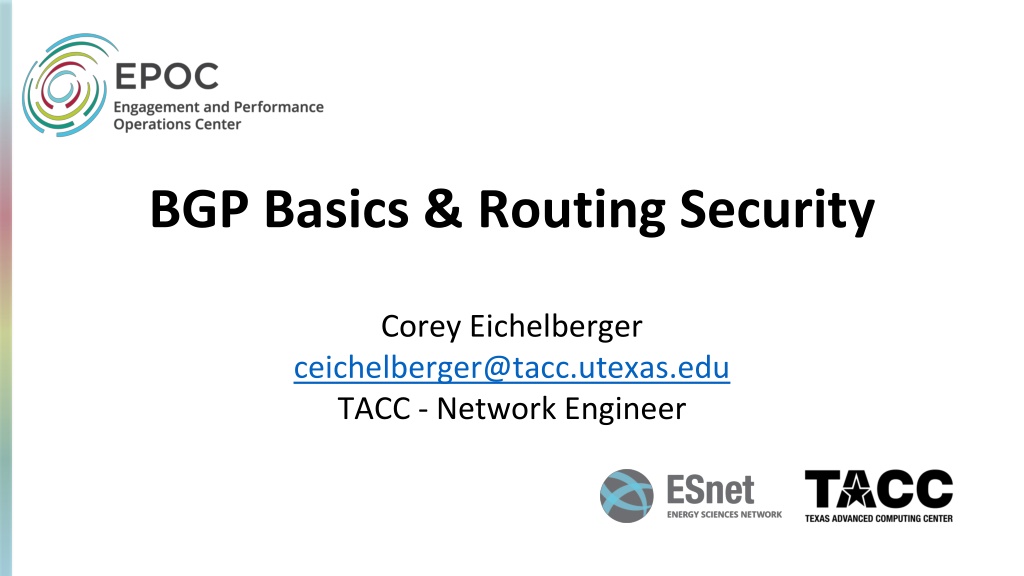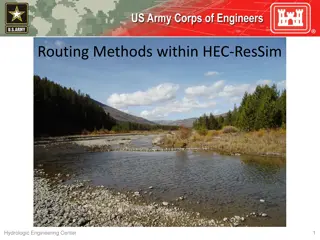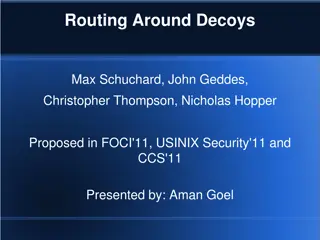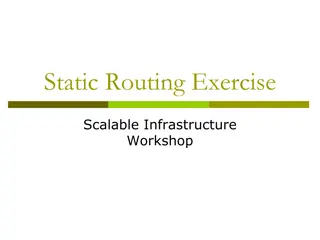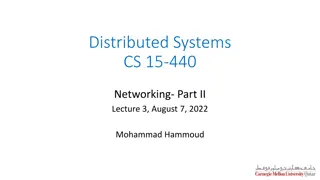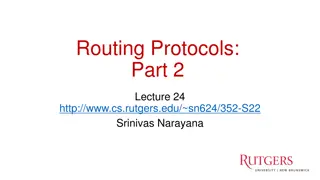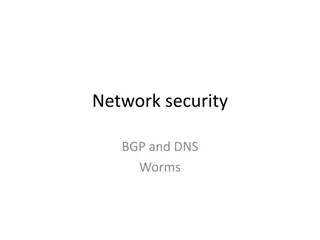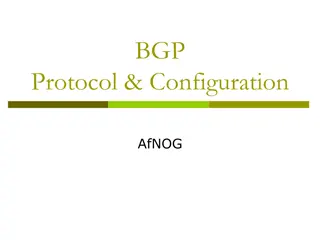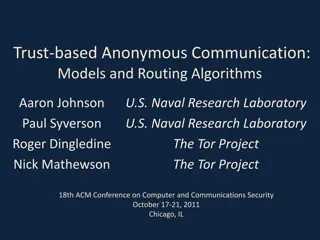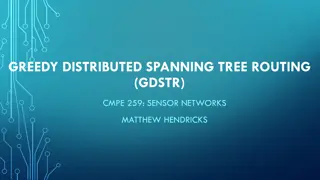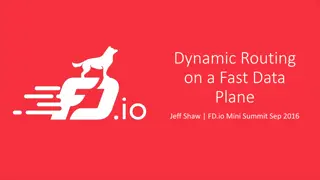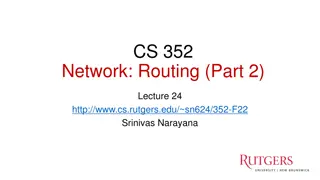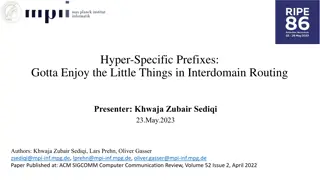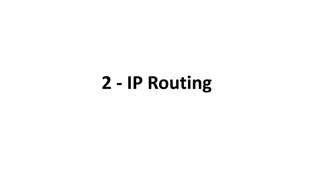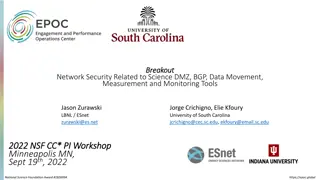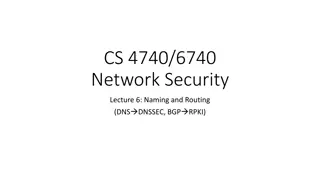Understanding BGP Basics and Routing Security
Border Gateway Protocol (BGP) is a crucial protocol used by routers to exchange routing information and make routing decisions. This protocol plays a key role in how the Internet functions, with over 76,000 Autonomous Systems and millions of routes being advertised. Research and Education (R&E) networks differ from commodity networks in their engineering to support scientific endeavors. Using BGP policy is essential for directing traffic effectively within these networks. Learn more about BGP, AS path lengths, and routing architecture differences.
Download Presentation

Please find below an Image/Link to download the presentation.
The content on the website is provided AS IS for your information and personal use only. It may not be sold, licensed, or shared on other websites without obtaining consent from the author. Download presentation by click this link. If you encounter any issues during the download, it is possible that the publisher has removed the file from their server.
E N D
Presentation Transcript
BGP Basics & Routing Security Corey Eichelberger ceichelberger@tacc.utexas.edu TACC - Network Engineer
What is BGP BGP or Border Gateway Protocol is protocol used between routers to exchange routing information and reachability information between or inside AS on the Internet. BGP makes the Internet work, and in most cases it just works Needs to be tuned for best performance BGP makes routing decisions based on paths, network policies and rule-sets, etc.
BGP in the wild - Modify Over 76,000 Autonomous Systems (ASN). Over 1,000,000 IPv4 routes advertised. Over 272,000 IPv6 routes advertised. Each Router running BGP builds its own routing table with best path information to a subset of the internet. 3 Data from: https://bgp.he.net/report/prefixes#_prefixes
R&E Routing Architecture Vs. Commodity. Research and Education Networks Bandwidth Performance Engineering Deterministic behavior Community Commodity Networks Traffic shaping DoS protections Unknown architecture R&E networks are engineered to support science while commodity networks are not Keep the science traffic on the science networks!
R&E vs. Commodity: What is the difference? Multiple cloud providers
So what do we do? High level : We need to use BGP policy to keep R&E traffic on R&E networks Announcements attract traffic Routing determines the path the traffic takes through the network - BGP gives us the tools BGP is a path vector protocol For a given prefix, the shorter AS path is preferred If AS path length is the same, then other criteria are used, in order ( BGP path selection algorithm ) Override BGP s use of AS path length when choosing between R&E and commodity paths R&E path will be longer in the general case (more organizations involved) Use normal BGP route selection between R&E routes, and between commodity routes Remember - hop count is a legacy metric
BGP AS Path Length Illustrated Hop count is a legacy metric!
BGP - Care and feeding BGP just works in many cases but needs tuned for performance Best path selection is a 10+ step process! Common steering mechanisms: Localpref Communities AS Padding MEDs
LocalPref Per prefix Modifies path for outbound traffic Higher preferred Good tool for keeping R&E traffic on R&E networks R&E Commodity Local
BGP Community Strings A community string is a number value that the peer uses like a tag. Tagging prefixes with communities tells the peer to handle the prefixes in a special way. Can make changes to routing policy based on per prefix strings Prefixes can have multiple community strings Can provide useful information about the prefix Communities that might be useful to external networks should be made public Provides a mechanism for peers to affect a network s internal behavior Common uses: change local preference, DDoS mitigation Look for upstream networks published communities Regional? National?
BGP Community Strings offered by Internet2 Set LocalPref on your advertised prefixes Default - 100 11537:40 - Low 11537:160 - High Prefix identification? 11537:5004 - Amazon Where does the prefix enter the network? 11537:242 New York Emergency! 11537:911 - Discard all traffic destined to these prefixes! AS Path Padding? 65001:65000 - prepend x1
AS Path Padding BGP will choose shortest AS Path Add one or more copies of your AS# to prefixes advertised to specific neighbors. * 180.208.59.0/24 202.112.61.57 - - - 4538 4538 24364 133465 133465 133465 65300 i
Multi Exit Discriminator (MED) Useful when you have N+1 connections to a network Indication to external peers of the preferred path into network Lowest number preferred MED: 5 Regional Regional MED: 10 Local
BGP is an OLD protocol Has been in use since 1994 https://datatracker.ietf.org/doc/html/rfc1654 Security was not a concern and not baked into the protocol Believes (without help) all advertisements from peers with no checks. It also by default can re-advertise to other peers what it learns. 14
Hijacking, Leaking, and spoofing MANRS reports over 10,000 routing outages or attacks in 2018* 40% of all incidents believed to be attacks. Incidents can quickly scale to global problems. 15 *https://www.manrs.org/2019/02/routing-security-getting-better-but-no-reason-to- rest/
Route / Prefix Hijacking When a network advertises/originates a route that belongs to another network (without permission) Not always malicious can easily be caused by misconfiguration 16 https://www.manrs.org/2020/09/what-is-bgp-prefix-hijacking-part-1/
Route / Prefix Hijacking - How it works AS Path length 17 https://www.manrs.org/2020/09/what-is-bgp-prefix-hijacking-part-1/
Example: Youtube and Pakistan Telecom Before, during and after Sunday, 24 February 2008: AS36561 (YouTube) announces 208.65.152.0/22. Sunday, 24 February 2008, 18:47 (UTC): AS17557 (Pakistan Telecom) starts announcing 208.65.153.0/24. AS3491 (PCCW Global) propagates the announcement. Routers around the world receive the announcement, and YouTube traffic is redirected to Pakistan. Sunday, 24 February 2008, 20:07 (UTC): YouTube changes to announcing two /24s. Some traffic starts going back to YouTube. 18 https://www.ripe.net/publications/news/industry-developments/youtube-hijacking- a-ripe-ncc-ris-case-study https://www.cnet.com/culture/how-pakistan-knocked-youtube-offline-and-how-to- make-sure-it-never-happens-again/
Example: Youtube and Pakistan Telecom 2 Sunday, 24 February 2008, 20:18 (UTC): AS36561 (YouTube) starts announcing 208.65.153.128/25 and 208.65.153.0/25. Because of the longest prefix match rule, every router that receives these announcements will send the traffic to YouTube. Sunday, 24 February 2008, 20:51 (UTC): All prefix announcements originated by AS17557 (Pakistan Telecom) via AS3491 (PCCW Global), are prepended by another 17557. The longer AS path means that more routers prefer the announcement originated by YouTube. Sunday, 24 February 2008, 21:01 (UTC): AS3491 (PCCW Global) withdraws all prefixes originated by AS17557 (Pakistan Telecom), thus stopping the hijack of 208.65.153.0/24. 19
Other Hijacking examples 2018: Amazon DNS routes hijacked and redirected to malicious DNS server: https://www.internetsociety.org/blog/2018 /04/amazons-route-53-bgp-hijack/ 2020: Rostelecom hijacks internet traffic for Google, AWS, Cloudflare, and others: https://www.zdnet.com/article/russian- telco-hijacks-internet-traffic-for-google- aws-cloudflare-and-others/ 20
Resource Public Key Infrastructure (RPKI) Regional Internet Registries (RIR s) certifies owners of AS numbers and IP addresses. They also certify route announcements Route Origin Authorization (ROAs) show that you are authorized to advertise the IP addresses Allows you to verify addresses advertised to your router are authorized to be advertised by that entity Router can set the route as Valid, Invalid, or unknown Create route policy depending on those results Allows reject on wrong AS, wrong prefix, or too specific advertisement 21 https://www.noction.com/blog/rpki-overview
Route Leak RFC7908 - A route leak is the propagation of routing announcement(s) beyond their intended scope. A multihomed stub network announces routes from one upstream providers routes to one or more of its other upstream providers Stub network becomes an inadvertent transit provider. Only announce AS s and prefixes that you originate. 22 https://datatracker.ietf.org/doc/html/rfc7908
Simple Campus/Institution Route Leak Example X: AS5, AS1 X: AS4, AS5, AS1 AS5 AS4 X: AS2, AS4, AS5, AS1 X: AS1 AS1 AS2 X X: AS2, AS3, AS1 X: AS3, AS1 AS3 Stub network AS3 creates route leak advertising AS1 to AS2. 23
Route Leak Example 2017: Rostelecom Route Leak Targets E- Commerce Services: https://www.thousandeyes.com/blog/roste lecom-route-leak-targets-ecommerce- services Confirmation that traffic destined for those E-Commerce sites went through the leakers network (possible inspection?) 24
Route Policy to fix Leaks - Overview BGP Operations and Security RFC: https://datatracker.ietf.org/doc/html/rfc7454 Includes lots of great best practices for AS and prefix filtering Good Primer: https://www.noction.com/wp- content/uploads/2019/08/BGP-Filtering-Best-Practices.pdf 25
Route Policy to fix Leaks - Inbound Loose Inbound Filtering Highlights include: Don t accept your own prefixes from a peer. Filter Bogons (Addresses not assigned) Be careful of more specific prefixes IPv4: more specific than a /24 IPv6: more specific than a /48 Strict Filtering: use scripts or tool to validate incoming prefixes against route registries. https://www.irr.net/ 26
Route Policy to fix Leaks - Outbound If you are a multihomed, only advertise what you originate. Don t advertise private space (RFC1918) Don t advertise ULA (fc:00/7) Prefixes used on your internal networks Don t re-advertise default route 27
IP Spoofing Attacker creates and send IP packets with false source address Commonly used in Distributed Denial of Service (DDOS) attacks DNS, memcached, NTP, UDP - lots of vulnerabilities November 2021: Microsoft detects and mitigates a 3.47Tbps (340 million packets per second) 15 minute long DDOS attack using UDP reflection. 28 https://azure.microsoft.com/en-us/blog/azure-ddos-protection-2021-q3-and-q4-ddos-attack- trends/
Source Address Validation and IP Spoofing Unicast Reverse Path Forwarding (uRPF) Router checks it s forwarding information table (FIB) for source address in each packet. Strict: Source Address must be reachable via incoming interface (strict) or in the FIB (loose) or packet is dropped. Can be done with ACL s as well but can require a lot of manual configuration. Best Current Practices (BCP) 38 http://www.bcp38.info/index.php/Main_Page https://datatracker.ietf.org/doc/html/rfc2827 29 https://learn.nsrc.org/bgp/urpf https://blog.apnic.net/2022/02/07/source-address-validation-use-cases-and-gap- analysis/
BGPSec RPKI doesn t validate the entire ASPATH of a prefix. BGPSec intended to verify the full path. https://datatracker.ietf.org/doc/html/rfc82 05 and more IETF working groups moving forward (https://datatracker.ietf.org/wg/sidrops/ab out/) No commercial implementations yet. few open source projects (https://github.com/usnistgov/NIST-BGP- SRx) 30
More Information Single point of contact to help with end-to-end performance issues: epoc@tacc.utexas.edu More about EPOC: http://epoc.global Deep Dive reports: https://epoc.global/materials Jennifer Schopf, jschopf@tacc.utexas.edu Jason Zurawski, zurawski@es.net
Other Resources MANRS https://manrs.org/ Routing Working Group Mailing list routing-wg@gna-g.net Contact Brenna Meade to be added meadeb@iu.edu Web https://www.gna-g.net/join-working-group/gna-g-routing-wg/
